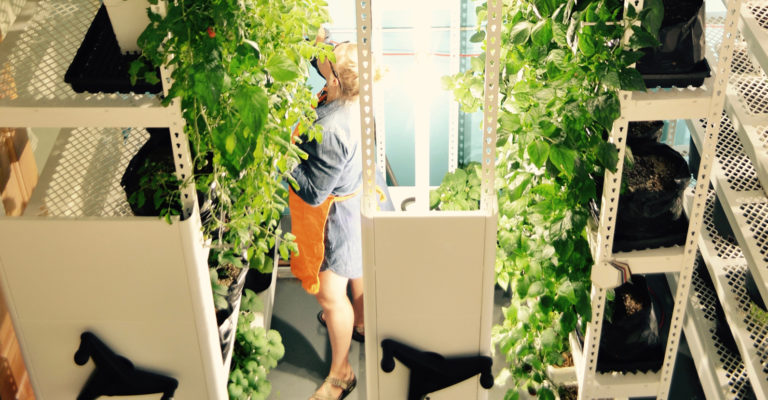
Vertical farming: What is it and how mobile storage can help
Photo courtesy of Brighterside Vertical Farms.
Vertical farming is the practice of producing food indoors on vertically inclined surfaces. By controlling light, temperature, water and often times carbon dioxide, vertical farmers are able to grow vegetables year-round in vertically stacked layers supporting leafy greens or vertical plant walls for larger fruiting plants.
As opposed to farming in a field, vertical farming takes up less space and can be integrated into other structures like skyscrapers, shipping containers and warehouses.
|
Vertical Farming is a rapidly growing market
Pushed by the need to feed an ever-growing global population (expected to exceed 9 billion people by 2050), the global vertical farming market is growing at an annual rate of 21.3% and is expected to reach $9.96 billion by 20251.
An increasing number of benefits
In addition to the growing population, there are a variety of reasons why a shift to vertical farming makes sense.
— Ability to provide locally sourced produce. Currently, leafy greens travel an average of 2,000 miles2 to reach your plate and some produce travels on ships and trucks for two weeks before it reaches your table. Vertical farming allows your food to be grown locally, even if you live in a New York City high-rise.
— Space savings. Vertical farmers can take advantage of height – thinking in terms of cubic space available, not just square feet. This can be further maximized with high-density carriages.
— Unaffected by weather. Traditional farming relies on weather for growth but extreme weather like hurricanes, tornadoes and snowstorms can cause lingering challenges including food loss. Vertical farms, like this one in Houston are built to withstand these storms. After Hurricane Harvey they only lost 5% of their product.
— No pests. Vertical farming is implemented in controlled indoor environments, so there is no need for pesticides.
— Water conservation. One vertical farming company reports they can grow 350 times the produce, using one percent as much water.3
— Ergonomics. Vertical racks limit bending and help to create an ergonomically designed workplace.
Get Started Vertical Farming
Vertical farming is not something that can be done without a solid plan in place. Evaluating your equipment options and determining the best fit to optimize your workflows and maximize labor efficiencies is important.
Here is a list of products you’ll need to get started:
— Lighting. Growers have many options for lighting, from LED to Fluorescent to HPS (high-pressure sodium) bulbs. Many farmers use vertical hoods to better distribute light.
— Watering system. Irrigation systems can water individual shelves or entire plant walls through drip emitters or sprayers. Indoor farming also allows for recycling water.
— Plant medium. Vertical farming supports nearly any medium plants are grown in, including soil, minerals, no-till, hydroponics, aeroponics and more.
— Container. Most systems can support either individual containers/pots or large trough style beds.
— Structure. Plant wall (for vertical plant walls): For vertical plant walls, vertical racks are used. Shelving is used for multi-tier stacked vertical farming. Plants can be stored on ventilated wide-span shelving or pallet racking, creating multiple tiers of growth.
— Trellis Netting. Provides additional support for plants.
Maximize your space with high-density
By implementing a high-density mobile solution, farmers can go one-step further in maximizing their grow space and yields. Adding the vertical plant rack, pallet rack or shelving to a mobile carriage will automatically increase storage space by 50% or more.
Be familiar with these terms if you’re going to implement a high-density mobile solution on your vertical farm.
— Tracks. For security and strength, mobile tracks are grouted in concrete. Due to moisture, many growers opt for extruded aluminum that is corrosion resistant and rust proof.
— Mobile Carriage. Wheeled carriages come in several lengths and widths and support several different types of shelving including pallet racking, wide span shelving and vertical racks for plant walls. Carriages can be light duty, heavy duty or powered, depending on the weight capacity needed to support the plants.
— Anti-tip device. Both static and mobile systems over 10’ high should use an overhead anti-tip device for stability. Pallet Racking does not need an overhead anti-tip.
Next steps
— Contact us to learn how TAB and our partner Brighterside Vertical Farms create high-density vertical storage for indoor farmers and cannabis growers
— See for yourself by visiting out our gallery of storage installations for indoor farms
— Read our previous blog to learn more about mobile storage for other industries
— Learn more about the equipment needed by downloading this infographic from Brighterside Vertical Farms
Sources:
1. Grand View Research. Vertical Farming Worth $9.96 Billion by 2025 “www.grandviewresearch.com/press-release/global-vertical-farming-market” 04.2019.
2/3. David Roberts. This company wants to build a giant indoor farm next to every major city in the world “https://www.vox.com/energy-and-environment/2017/11/8/16611710/vertical-farms” Vox. 04.11.2018


